|
|
 |
Fiche d'espèce de Copépode |
|
|
Calanoida ( Ordre ) |
|
|
|
Arietelloidea ( Superfamille ) |
|
|
|
Arietellidae ( Famille ) |
|
|
|
Arietellus ( Genre ) |
|
|
| |
Arietellus setosus Giesbrecht, 1892 (F,M) | |
| | | | | | | Syn.: | ? Arietellus setosus : Esterly, 1911 (p.335, figs.M) | | | | Ref.: | | | Giesbrecht, 1892 (p.415, Descr.M, figs.M); 1897 b (p.254); Giesbrecht & Schmeil, 1898 (p.124); Esterly, 1905 (p.189, figs.F); A. Scott, 1909 (p.142, figs.F,M); Wolfenden, 1911 (p.329, fig.F); Pesta, 1920 (p.535); Sars, 1925 (p.328, figs.F,M); Farran, 1929 (p.269); Rose, 1929 (p.36); Candeias, 1926 (1929) (p.40, figs.F:?); Farran, 1929 (p.210, 269, Rem.); Sewell, 1932 (p.329); Rose, 1933 a (p.239, figs.F,M); Jespersen, 1934 (p.116); 1940 (p.63); Wilson, 1942 a (p.171, figs.F,M); Lysholm & al., 1945 (p.40); C.B. Wilson, 1950 (p.168, figs.F,M); Brodsky, 1950 (1967) (p.395, figs.F,M); Grice, 1962 (p.226, figs.M); Vervoort, 1965 (p.153, Rem.); Owre & Foyo, 1967 (p.90, figs.F,M); Mazza, 1967 (p.203, figs.F,M, juv.); Park, 1968 (p.566, Rem.); Razouls, 1972 (p.95, Annexe: p.83); Björnberg & al., 1981 (p.654, figs.F,M); Schnack, 1989 (p.137, tab.1, fig.6: Md); He & al., 1992 (p.250); Ohtsuka & al., 1994 (p.131, Rem.M, figs.M); Heinrich, 1996 (p.1782, figs.F); Chihara & Murano, 1997 (p.720, Pl.: 54: F); Bradford-Grieve & al., 1999 (p.882, 937, figs.F,M); Boxshall & Halsey, 2004 (p.63: fig.M); Vives & Shmeleva, 2007 (p.152, figs.F,M) | 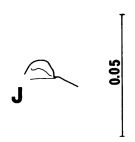 issued from : S. Ohtsuka, G.A. Boxshall & H.S.J. Roe in Bull. nat. Hist. Lond. (Zool.), 1994, 60 (2). [p.132, Fig.16, J]. Male (off Mauritania): J, endopod of Mx1. Nota: endopod of Mx1 represented by unarmed, small knob. Scale bar in mm.
|
 issued from : S. Ohtsuka, G.A. Boxshall & H.S.J. Roe in Bull. nat. Hist. Lond. (Zool.), 1994, 60 (2). [p.134, Fig.18, I,M]. Male: I, 4th to 6th endopod segments of Mxp; M, left endopod of P5. Scale bars in mm. Nota: Exopod of A2 indistinctly 7-segmented (setal formula: 0, 1, 1, 1, 1, 0, 3, respectively). 1st exopod segment of Md with normally developed seta. endopod of Mx1 represented by unarmed, small knob. P5 with left endopod (Fig.18 M) indistinctly 2-segmented, 1st segment produced ventrally to rounded tip, 2nd segment rising from inner side of 1st segment; terminal spine on 3rd exopod segment of left leg almost completely fused to segment, subterminal spine incompletely coalesced with segment; distal compound exopod segment of right leg unarmed.
|
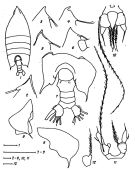 issued from : A.K. Heinrich in Zool. Zh., 1996, 75 (12). [p.1782, Fig.5]. Female (from SW Indian Ocean): 1, habitus (dorsal); 2, forehead (lateral); 5-6, idem (variant, 6: abnormal); 7, last thoracic segment and urosome (dorsal); 8-9, postrolateral corners of last thoracic segment (left side and right side, respectively); 10, P5; 11, idem (abnormal); 12, endopodite of abnormal P5. Scale bars in mm: 1.0 (1, 7-9); 0.100 (2-6, 10-12).
|
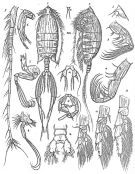 Issued from : G.O. Sars in Résult. Camp. Scient. Prince Albert I, 69, pls.1-127 (1924). [Pl.CXVIII, figs.1-16]. Female: 1, habitus (dorsal); 2, idem (lateral lef side); 3, forehead (lateral); 4, rostrum; 5, A1; 6, A2; 7, Md; 8, Mx1; 9, Mx2; 10, Mxp; 11, P1; 12, P3; 13, P4; 14, P5. Male: 15, P5; 16, distal part of urosme and caudal rami (dorsal).
|
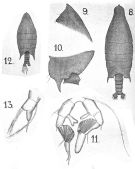 issued from : A. Scott in Siboga-Expedition, 1909, XIX a. [Plate XLIV, Figs.8-13]. Male (from Molucca Passage and Banda Sea): 8, habitus (dorsal); 9, forehead (lateral); 10, last thoracic and genital segments (left side); 11, P5. Female (after Esterly), 1905: 12, habitus (dorsal); 13, P5.
|
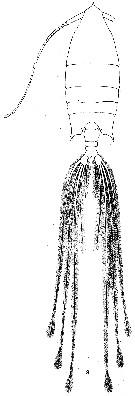 issued from : R.N. Wolfenden in Die Marinen Copepoden der Deutschen Südpolar-Expedition 1901-1903, 1911. [Pl.XXXVI, Fig.3]. Female: habitus (dorsal).
|
 Issued from : W. Giesbrecht in Systematik und Faunistik der Pelagischen Copepoden des Golfes von Neapel und der angrenzenden Meeres-Abschnitte. – Fauna Flora Golf. Neapel, 1892. Atlas von 54 Tafeln. [Taf.29, Figs.3, 4, 5, 6]. Male: 3, right A1 (distal segments); 4, Md (inner view); 5, Md (mandibular palp; outer view); 6, Md (biting edge).
|
 Issued from : W. Giesbrecht in Systematik und Faunistik der Pelagischen Copepoden des Golfes von Neapel und der angrenzenden Meeres-Abschnitte. – Fauna Flora Golf. Neapel, 1892. Atlas von 54 Tafeln. [Taf.29, Fig.21]. Male: 21, A2 (anterior view). Re = exopod.
|
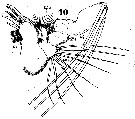 Issued from : W. Giesbrecht in Systematik und Faunistik der Pelagischen Copepoden des Golfes von Neapel und der angrenzenden Meeres-Abschnitte. – Fauna Flora Golf. Neapel, 1892. Atlas von 54 Tafeln. [Taf.29, Fig.10]. Male: 10, Mx1 (posterior view).
|
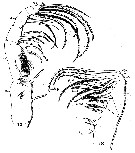 Issued from : W. Giesbrecht in Systematik und Faunistik der Pelagischen Copepoden des Golfes von Neapel und der angrenzenden Meeres-Abschnitte. – Fauna Flora Golf. Neapel, 1892. Atlas von 54 Tafeln. [Taf.29, Figs.12, 13]. Male: 12, Mxp (anterior view); 13, Mx2 (posterior view).
|
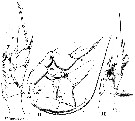 Issued from : W. Giesbrecht in Systematik und Faunistik der Pelagischen Copepoden des Golfes von Neapel und der angrenzenden Meeres-Abschnitte. – Fauna Flora Golf. Neapel, 1892. Atlas von 54 Tafeln. [Taf.29, Figs.7, 9, 11]. Male: 7, P2 (anterior view); 9, P5 (anterior view); 11, P1 (anterior view). Ps = left leg; Pd = right leg.
|
 Issued from : W. Giesbrecht in Systematik und Faunistik der Pelagischen Copepoden des Golfes von Neapel und der angrenzenden Meeres-Abschnitte. – Fauna Flora Golf. Neapel, 1892. Atlas von 54 Tafeln. [Taf.39, Fig.36] Male: 36, habitus (dorsal)
|
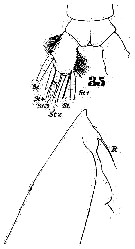 Issued from : W. Giesbrecht in Systematik und Faunistik der Pelagischen Copepoden des Golfes von Neapel und der angrenzenden Meeres-Abschnitte. – Fauna Flora Golf. Neapel, 1892. Atlas von 54 Tafeln. [Taf.39, Figs.34, 35] Male: 34, head (lateral) with rostrum (R); 35, anal segment and caudal rami (dorsal).
|
 issued from : C.O. Esterly in Univ. Calif. Publs Zool., 1911, 6 (14). [Pl.27, Figs.22, 23]. With doubt. Male: 22, forehead (lateral); 23, habitus (lateral).
|
 issued from : C.O. Esterly in Univ. Calif. Publs Zool., 1911, 6 (14). [Pl.30, Figs.81-82]. With doubt. Male: 81-82, P5.
|
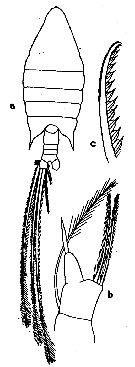 issued from : C.O. Esterly in Univ. Calif. Publs. Zool., 1905, 2 (4). [p.190, Fig.42]. Female (from San Diego Region): a, habitus (dorsal); b, P5; c, distal portion of one of the bristles of Mx2.
|
 issued from : G.D. Grice in Fish. Bull. Fish and Wildl. Ser., 1962, 61. [p.227, Pl.27, Figs.1-4]. Male (from 01°10'S, 134°57'W): 1-2, habitus (dorsal and lateral, respectively); 3, posterior part of thorax and urosome (dorsal); 4, P5. Nota: The posterior thoracic margins are widely divergent. The forehead terminates in an acute point.
|
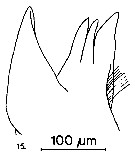 issued from : S.B. Schnack in Crustacean Issue, 1989, 6. [p.143, Fig.6: 15]. 15, Arietellus setosus (from off NW Africa, upwelling region): Cutting edge of Md.
|
 Issued from : J.M. Bradford-Grieve in NIWA Biodiversity Mem. 111, 1999.[p.30, Fig.8].
Male: (After Giesbrecht, 1892): A, dordsal); B, head (lateral); C, posterior urosome (doesal); D, left A2; E, right A1 terminal part; F, A2; G, Md; H, mandibular palp; I, distal end of Md blade; J, Mx1; K, Mx2; L, Mxp; M, P1; N, P5.
|
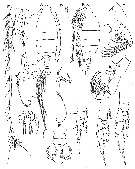 Issued from : J.M. Bradford-Grieve in NIWA Biodiversity Mem. 111, 1999.[p.29, Fig.7].
Female (after Sars, 1924): A-B, habitus (dorsal and lateral, respectively); C, forehead (lateral); D, rostrum; E, posterior urosome (dorsal); F, A1; G, A2; H, Md; I, Mx1; J, Mx2; K, Mxp; L, P1; M, P3; N, P4; O, P5.
Nota: Forehead narrow terminating in a short conical projection which is poineted at its end.
- Posterolateral corners of last thoracic segment strongly projecting on both sides and terminating in a point with is directed obliquely outwards.
- A1 extends almost as far as posterior corners of prosome.
- Genital segment short.
- Caudal rami slightly lamelliform with extremely long, slender setae some of which are almost as long as entire body
| | | | | Ref. compl.: | | | Sewell, 1948 (p.350, 505, 509, 512, 514, 517, 526, 548, 549, 559); Grice & Hart, 1962 (p.287, 293: Rem.); De Decker & Mombeck, 1964 (p.11); Mazza, 1966 (p.72); Fleminger, 1967 a (tabl.1); Grice & Hulsemann, 1968 (tab.2); Vinogradov, 1968 (1970) (p.195, 268); Morris, 1970 (p.2301); Deevey, 1971 (p.224); Roe, 1972 (p.277, tabl.1, tabl.2); Bainbridge, 1972 (p.61, Appendix Table III: occurrence); Björnberg, 1973 (p.349, 386); Vives & al., 1975 (p.52, tab.II); Deevey & Brooks, 1977 (p.156, tab.2, Station "S"); Carter, 1977 (1978) (p.36); Stephen & Rao, 1980 (p.242); Vives, 1982 (p.294); Kovalev & Shmeleva, 1982 (p.85); Scotto di Carlo & al., 1984 (1044); Guangshan & Honglin, 1984 (p.118, tab.); Madhupratap & Haridas, 1986 (p.105, tab.1); Scotto di Carlo & al., 1991 (p.271); Seguin & al., 1993 (p.23); Shih & Young, 1995 (p.67); Hure & Krsinic, 1998 (p.102); Suarez-Morales & Gasca, 1998 a (p108); Pakhomov & al., 2000 (p.1663, Table 2, transect Cape Town-SANAE antarctic base); Holmes, 2001 (p.14); Vukanic, 2003 (p.139, tab.1); Hsiao & al., 2004 (p.325, tab.1: as Arietella setosus); Galbraith, 2009 (pers. comm.); Schnack-Schiel & al., 2010 (p.2064, Table 2: E Atlantic subtropical/tropical); Mazzocchi & Di Capua, 2010 (p.423); Andersen N.G. & al., 2011 (p.71, Fig.3: abundance); in CalCOFI regional list (MDO, Nov. 2013; M. Ohman, pers. comm.); Lidvanov & al., 2013 (p.290, Table 2, % composition); El Arraj & al., 2017 (p.272, table 2, spatial distribution); Belmonte, 2018 (p.273, Table I: Italian zones) | | | | NZ: | 18 | | |
|
Carte de distribution de Arietellus setosus par zones géographiques
|
| | | | | | | | | | | |  issued from : R. Stephen & T.S.S. Rao in J. Plankton Res., 1980, 2 (2). [p.242, Fig.1]. issued from : R. Stephen & T.S.S. Rao in J. Plankton Res., 1980, 2 (2). [p.242, Fig.1].
Distribution of Arietellus and Paraugaptilus in the Indian Ocean (open circles indicate the stations selected for the study). |
| | | | Loc: | | | sub-Antarct. (in Björnberg, 1973, p.384), South Africa (E), Atlant. (tropical), S Brazil, G. of Guinea, off Lagos, off Morocco-Mauritania, Moroccan coast, Canary Is.- Azores, off N Azores, Portugal, Bay of Bicay, off W Ireland, N Scotland, Strait of Davis, S Iceland, off Amazon, Barbada Is., Yucatan, Florida, Sargasso Sea, off Bermuda (Station "S"), Ibero-morocco Bay, Medit. (Alboran Sea, Banyuls, Ligurian Sea, Tyrrhenian Sea, Strait of Messina, Adriatic Sea, Ionian Sea), Natal, S Madagascar, Indian, Indonesia-Malaysia, Philippines, China Seas (East China Sea, South China Sea), Japan (Honshu), off SE Hokkaido, Vancouver Is., California, Pacif. (W equatorial), New Zealand, Pacif. (equatorial), NE Marquesas Is., off Hawaii (N & NE), off Ecuador, off Juan Fernandez Is., N Chile | | | | N: | 75 | | | | Lg.: | | | (1) F: 4,9; (5) M: 4; (10) F: 4,75-4,6; (16) M: 4,45-4,2; (35) F: 5,08; M: 4,2-4,02; (46) M: 4,25; (47) F: 4,6; (71) M: 4,28; (72) M: 4,12-3,93; (101) M: 3,99; (142) F: 5,5; (143) M: 6,2; (199) M: 3,95; (207) F: 4,6-4,27; M: 4,03-3,99; (449) F: 4,6; M: 4,25; (852) F: 4,87-5,05; {F: 4,27-5,50; M: 3,93-6,20} | | | | Rem.: | épi-méso-bathypélagique.
Voir aussi les remarques en anglais | | | Dernière mise à jour : 25/10/2022 | |
|
|
 Toute utilisation de ce site pour une publication sera mentionnée avec la référence suivante : Toute utilisation de ce site pour une publication sera mentionnée avec la référence suivante :
Razouls C., Desreumaux N., Kouwenberg J. et de Bovée F., 2005-2025. - Biodiversité des Copépodes planctoniques marins (morphologie, répartition géographique et données biologiques). Sorbonne Université, CNRS. Disponible sur http://copepodes.obs-banyuls.fr [Accédé le 03 janvier 2026] © copyright 2005-2025 Sorbonne Université, CNRS
|
|
 |
 |






















